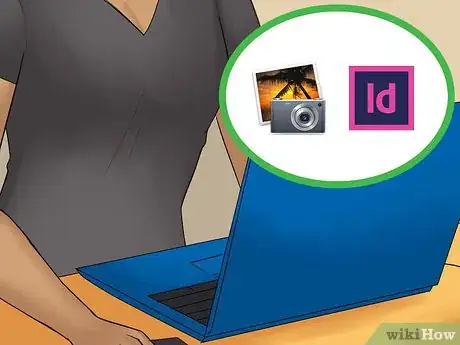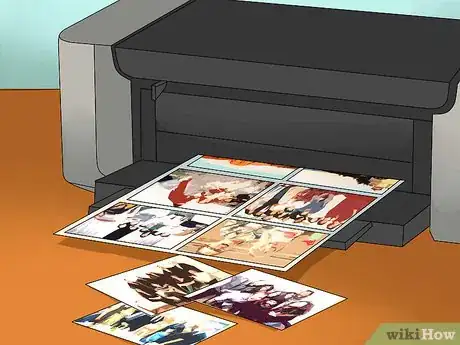This article was co-authored by William Gardner, PsyD. William Gardner, Psy.D. is a Clinical Psychologist in private practice located in San Francisco, CA’s financial district. With over 10 years of clinical experience, Dr. Gardner provides individually tailored psychotherapy for adults using cognitive behavioral techniques, to reduce symptoms and improve overall functioning. Dr. Gardner earned his PsyD from Stanford University in 2009, specializing in evidence-based practices. He then completed a post-doc fellowship at Kaiser Permanente.
There are 13 references cited in this article, which can be found at the bottom of the page.
wikiHow marks an article as reader-approved once it receives enough positive feedback. In this case, 100% of readers who voted found the article helpful, earning it our reader-approved status.
This article has been viewed 160,090 times.
Memorial books allow you to commemorate the life of a loved one while helping you process your grief and emotions. Gather photographs, memories, and stories to help honor their life. Once you know what you in the memorial book, you can choose how you will produce it. There are two ways to make a memorial book. You can design a photo book on the computer and have it printed professionally. This allows you to make many copies and give them out to family members. Alternatively, you can make a scrapbook by hand for a unique, one-of-a-kind book.
Steps
Designing Your Book
-
1Collect pictures of your loved one. Find all of the images you have of your loved one, and go through them. Pick out which ones are most meaningful to you, your family, and the friends of the deceased. Photographs should represent their life, personality, and milestones.
- If the photos are digital, you can organize them in files on your computer. You might organize them by date, theme, or relevance. Or, you can put them on a flash drive and print them out.
- If the photographs are physical copies, you should scan and digitize them before putting them in a book. This saves the original while giving you plenty of copies to work with. If you do not own a scanner, check out your local public library to see if they offer scanning services.
- If you are having trouble choosing, you can look for the major milestones of their life: baby pictures, graduations, weddings, award ceremonies, vacations, and other big events.
- Invite family members and friends to add their photos to the book. You can do this at the funeral service, through letters, or over email.
-
2Record your memories. Think of the happiest moments you had with the deceased. Write these down in detail. These memories will be immortalized in your memorial book. You should also ask family and friends to write down their own unique stories. You can ask people:[1]
- What is your favorite memory of the deceased?
- Is there something that the deceased told you that you will always remember?
- What kinds of traditions did you have with the deceased?
- How long did you know them for?
- How did you first meet the deceased?
Advertisement -
3Think about their favorite things. You can decorate the memorial book with other images and items that remind you of your loved one. These can be newspaper articles they were featured in, awards they won, images of their favorite hobby, or their favorite things.
- For example, if your loved one was an artist, you might include a few images of their artwork.
- If the deceased loved animals, you might include a few pictures of their favorite pets.
- You might also include things that represent historical events that they witnessed.[2] For example, you can add news articles of elections or tickets of famous concerts.
-
4Include messages from family and friends. In addition to memories and stories, you should write your loved one a heartfelt goodbye that shows how much you love and miss them. These notes can help you process your grief, and they are a permanent testament to how much the deceased was loved. Make sure to ask for contributions from others as well.[3]
- For example, you might write, “Dad, I think of you every day. You were such an inspiration in my life, and I still love you so much. While I miss you dearly, I hope that wherever you are, you're peaceful.”
- You can also try writing a letter to the deceased where you tell them things that you never got to say. For example, you might write, “I was always too proud to admit how much I looked up to my big brother, but now I just want to say, you were always my inspiration.”[4]
- Include the obituary and eulogy. If you don't want to start from scratch with the person's life story, you can take the obituary and eulogy from their funeral. These can be copied and pasted into your book.[5]
-
5Find quotes. Quotations about death, love, and family can help you define how you are feeling in eloquent language. They are great ways to decorate and fill a memorial book.[6] If your loved one had a favorite poem or prayer, you can include those as well. Some general quotes include:
- ”Unable are the loved to die for love is immortality.” --Emily Dickinson
- “The song is ended, but the melody lingers on.” --Irving Berlin
- “It is not length of life, but depth of life.” --Emerson Ralph Waldo
-
6Organize your materials. Choose a theme to help organize your book, and break the theme down into four or five different sections. Think about what stories and photographs will go in each section. Your theme might be the story of their life, or it might focus on childhood, marriage, or hobbies.
- If you are arranging sections chronologically, make sure to include the dates that are associated with each picture and story.
- You can have different sections marked by different titles. For example, “Love of Her Life” can be the title for a section on your loved one's marriage. “Never forgotten” can be the title of a section on their funeral.[7]
Printing Your Book Using a Photo Book Service
-
1Choose your preferred bookmaking application. There are different applications that you can use to design your book. Some, such as iPhoto and Adobe InDesign, will help you format and design the layout, but they will not print the book for you. Other services, like Snapfish and Shutterfly, will offer basic templates for you to upload images, and they will print and ship you the final product. Think about your needs, skills, and timetable to choose an application that will work best for you.
- If you want a service that will give you premade templates and print the book for you, Shutterfly, Snapfish, and Bookify offer basic layouts.
- Photo editing programs such as Adobe InDesign, Lightroom, and iPhoto can be used to make more advanced, personalized pages. You can then upload these files to a self-publishing service such as Blurb to have them printed.[8]
-
2Decide on a size. The size of the book will determine the price of the book as well as how many pictures you can put inside of it. Common sizes include eight by eight inches, eight by ten inches, ten by eight inches, and twelve by twelve inches.
- An eight by eight book will have no more than six to eight pictures per two pages, while a twelve by twelve book can have up to ten or twelve.[9]
- Most photo books will start at about twenty pages per book, regardless of size, although you may be able to pay for extra pages.
- Photo book services tend to start at around fifteen to twenty dollars for a basic eight by eight book, whereas a twelve by twelve book can start at around sixty dollars. Extra pages, special bindings, and shipping can add to the price.
-
3Choose templates. If you are using a photo service, such as Shutterfly or Bookify, to create your layout, you will have the option of choosing from many templates. These free templates will show you how the pictures will be organized on the page, and they may even have room for text or graphic illustrations. Each page can have a different layout, and you should look over all of your options carefully.
- Consider how you are breaking up your book into sections. How many pictures do you have for each section? Roughly how many pictures do you need per page?
- Choose a variety of layouts that include different photo numbers and sizes so that your book has a different layout on each page.[10]
-
4Upload photos. Most photo book services will allow you to upload photographs from your computer, and some may even let you choose photographs from social media websites, such as Facebook or Instagram. Vary the type of photographs that you use. You may want to use a mix of horizontal and vertical images to create variety in your photo book.[11]
-
5Type in your stories and memories. Most photo book services will allow you to add text boxes to a layout. You can add the stories, memories, quotes, poems, and letters from your family in these photo books. Type them up first in a word document so that you can proofread it and save the stories. Copy and paste them into the text boxes on your layout.
- You may want to keep these memories and stories brief to allow for more room for images.
-
6Order copies. If you used an all-in-one service like Shutterfly or Snapfish, you can order the book as soon as you are done formatting it. Order as many copies as you need to hand out to family or friends. You can also just print one copy and set it out at the funeral.
- If you used your own photo editing program, simply find a self-publishing program that will let you upload and publish your book. Blurb offers options for this.
- Some services may take a few days to produce your book, even if you select rush shipping. Research your service ahead of time to make sure that you can get your book when you need it.[12]
Creating a Scrapbook
-
1Choose a book. Scrapbooks typically have blank pages where photographs can be pasted or taped onto the page. Furthermore, you can typically buy extra pages to add to the book. When selecting a scrapbook, think about its purpose and design. You might want a small and portable scrapbook, or you might want a big one that can fit many pictures onto one page.
- You can buy scrapbooks at art stores or stationery stores.[13]
- Most scrapbooks will come with properly sized sleeves and paper pages. You can also buy additional sleeves or pages.
- Photo albums are different from scrapbooks in that they have individual sleeves for each photograph. Photo albums do not typically have space for other documents. If you want to use a photo album, you can hand write your memories on the back of the photograph.
-
2Print out your photographs. You can use a professional printing service or your own printer to produce the photographs. To make sure that they last a long time, you should have them printed on a heavy weight of glossy paper. Choose acid-free paper with a neutral PH. You might want to print out multiple copies of each image just in case you make a mistake.
- If you print the photographs yourself, you can find glossy photo paper at an office supply store. Be careful while cutting out the images to make sure that your lines are straight.
-
3Gather important documents. Scrapbooks are a great place to include all of the important documents of your loved one's life. This includes newspaper articles, certificates, artwork, and other items from throughout their life. You can paste these directly into the book.
- Be careful with originals as you may not have a copy if you make a mistake or tear it.
- Make sure that this memorabilia is flat so that you can fit in the scrapbook.[14]
- You can also include items that represent their life. For example, if your loved one was a gardener, you might include a pressed flower. Or if your loved one taught gymnastics, you might include a pamphlet from their gym.
-
4Write your messages out. You can write your special messages to the deceased directly on the page or glue them on. You can either hand-write your words on card stock or paper, or you can type up your words and print them. Cut the words out of the paper before inserting into your scrapbook.
- If you are handwriting messages or dates, you can use brightly colored pens. Gel pens, permanent markers, and fountain pens are a great way to add a personal touch to the scrapbook.
-
5Arrange your memorabilia. Once you have printed your photos and messages, you can start to organize them on the page. Before you glue anything, organize the photographs, letters, and other memorabilia on the page to see how they look together. Rearrange the items until you have a design that you like. You can adhere the item to the page with glue, tape, glue dots, or photo corners.
- If your scrapbook came with page protectors, slide the page out of the sleeve before adhering your items to the page. Allow the glue to dry before sliding it back in.
-
6Decorate the book. You can use paper, ribbons, pens, and stickers to decorate the scrapbook. Think about the personality of the deceased. What images and decorations represent them best? Look at your local stationery store or craft store for options and ideas.
- Letter stickers can be used to spell out titles for each section.[15]
- If your loved one had a favorite color, you can find that color in card stock. Use the card stock to frame or outline photographs. To do this, trace the photograph on the card stock, and then create a border of about half an inch outside of that. Cut out the card stock, and paste the photograph to it before putting it in the scrapbook.
- If your loved one traveled frequently, you can find stickers of different flags and places to put next to their travel pictures.
- While your scrapbook probably came with plain paper pages, you can also buy colorful pages or pages with print designs.
Expert Q&A
-
QuestionHow do you honor a deceased person?
 William Gardner, PsyDWilliam Gardner, Psy.D. is a Clinical Psychologist in private practice located in San Francisco, CA’s financial district. With over 10 years of clinical experience, Dr. Gardner provides individually tailored psychotherapy for adults using cognitive behavioral techniques, to reduce symptoms and improve overall functioning. Dr. Gardner earned his PsyD from Stanford University in 2009, specializing in evidence-based practices. He then completed a post-doc fellowship at Kaiser Permanente.
William Gardner, PsyDWilliam Gardner, Psy.D. is a Clinical Psychologist in private practice located in San Francisco, CA’s financial district. With over 10 years of clinical experience, Dr. Gardner provides individually tailored psychotherapy for adults using cognitive behavioral techniques, to reduce symptoms and improve overall functioning. Dr. Gardner earned his PsyD from Stanford University in 2009, specializing in evidence-based practices. He then completed a post-doc fellowship at Kaiser Permanente.
Clinical Psychologist There's no right or wrong way to honor a loved one you've lost. Everyone goes through the stages of grief differently, so don't be hard on yourself if you find yourself jumping around from emotion to emotion. Every culture has a different way of honoring the deceased. In Judaism, for example, you do an unveiling of the tombstone after one year, and that's the end of official grieving. You could do something like that, or you could just share your favorite memories with your other loved ones. There's no rule book when it comes to this kind of thing.
There's no right or wrong way to honor a loved one you've lost. Everyone goes through the stages of grief differently, so don't be hard on yourself if you find yourself jumping around from emotion to emotion. Every culture has a different way of honoring the deceased. In Judaism, for example, you do an unveiling of the tombstone after one year, and that's the end of official grieving. You could do something like that, or you could just share your favorite memories with your other loved ones. There's no rule book when it comes to this kind of thing.
Warnings
- Try not to include any painful memories or sensitive topics in the memorial book. This is especially true if you are sharing it with family and friends.⧼thumbs_response⧽
- Expedited shipping can be expensive on photo books.⧼thumbs_response⧽
- If you feel as though your grief is overwhelming, seek help. Ask family and friends to support you, and consider consulting a therapist.[16]⧼thumbs_response⧽
Things You'll Need
- Digital book publishing software (options listed in External Links below)
- Scanner
- Digital camera
- Printer
- Glossy photo paper
- Photographs
- Scrapbook
- Scrapbooking paper or card stock
- Memorabilia
- Glue
- Pens
- Markers
- Stickers
References
- ↑ http://www.dennydavis.net/poemfiles/mem1.htm
- ↑ http://psychcentral.com/blog/archives/2016/06/12/5-creative-ideas-for-keeping-your-loved-ones-memory-alive/
- ↑ http://www.dennydavis.net/poemfiles/mem1.htm
- ↑ https://www.ucdmc.ucdavis.edu/hr/hrdepts/asap/Documents/Coping_with_Grief.pdf
- ↑ http://www.griefhealing.com/column-helping-another-in-grief.htm
- ↑ http://www.dennydavis.net/poemfiles/mem1.htm
- ↑ http://www.dennydavis.net/poemfiles/mem1.htm
- ↑ http://www.consumerreports.org/digital-cameras-photography/do-it-yourself-photo-books-make-great-holiday-gifts/
- ↑ http://digital-photography-school.com/5-top-tips-for-designing-good-photo-book-layouts/
- ↑ http://lovelyindeed.com/how-to-make-a-yearly-family-photo-book/
- ↑ http://www.consumerreports.org/digital-cameras-photography/do-it-yourself-photo-books-make-great-holiday-gifts/
- ↑ http://www.consumerreports.org/digital-cameras-photography/do-it-yourself-photo-books-make-great-holiday-gifts/
- ↑ http://www.us-funerals.com/funeral-articles/how-to-create-your-own-memorial-tributes.html#How%20to%20create%20a%20Memorial%20Book%20for%20a%20funeral
- ↑ http://psychcentral.com/blog/archives/2016/06/12/5-creative-ideas-for-keeping-your-loved-ones-memory-alive/
- ↑ http://www.dennydavis.net/poemfiles/mem1.htm
- ↑ William Gardner, PsyD. Clinical Psychologist. Expert Interview. 25 July 2019.

















































































